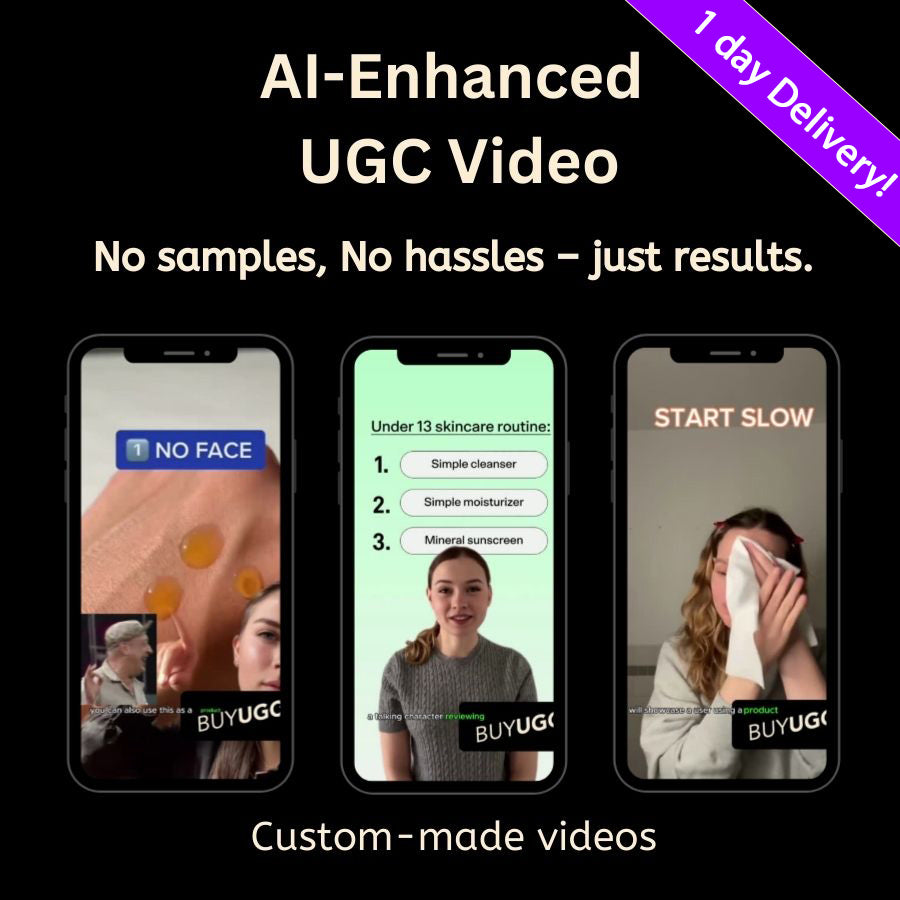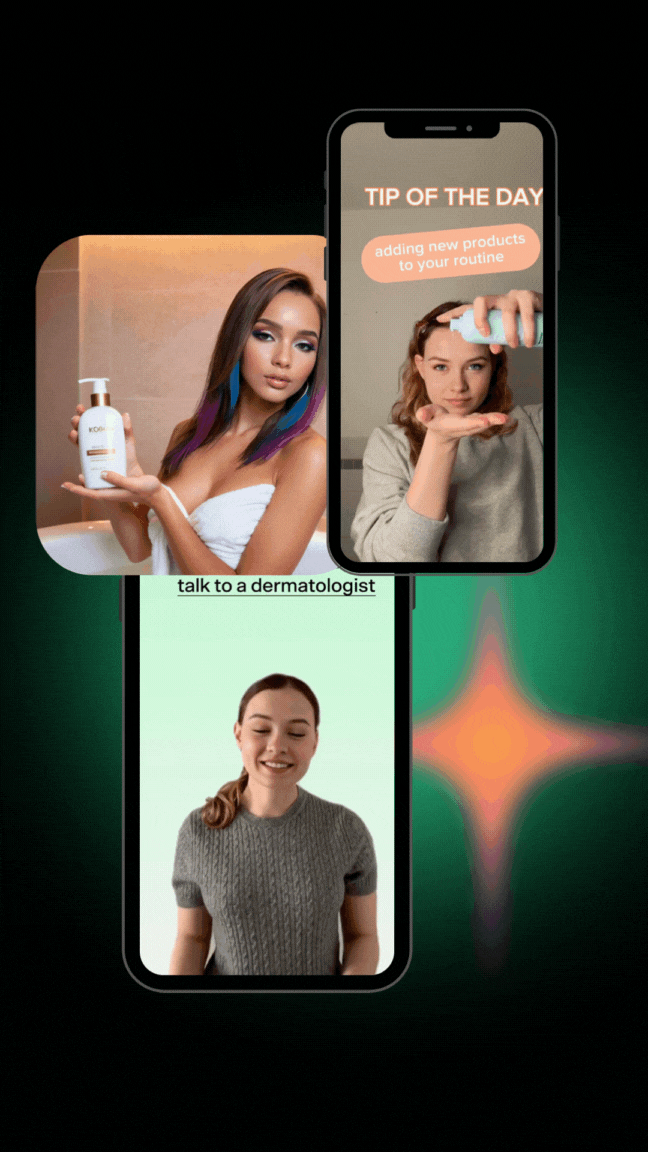In today's digital landscape, user-generated content (UGC) has become a powerful tool for businesses looking to connect with their audience in a more authentic and engaging way. With the rise of social media and online communities, consumers are increasingly turning to UGC to inform their purchasing decisions and engage with brands on a more personal level.
What is User-Generated Content?
User-generated content refers to any form of content - whether it's images, videos, reviews, or social media posts - that is created and shared by consumers rather than brands. It's authentic, genuine, and often carries more weight with potential customers than traditional marketing materials.
Image-Based User-Generated Content:
Image-based UGC consists of photos, illustrations, and graphics created and shared by users. This could include product photos, selfies with your products, user-generated artwork, or photos of customers using your services. Visual content is highly engaging and can help to showcase your products or services in a real-life context.
Video-Based User-Generated Content:
Video-based UGC includes user-generated videos, such as product demonstrations, unboxing videos, customer testimonials, or user-generated commercials. Video content is incredibly popular and can be highly persuasive in convincing potential customers to make a purchase.
Review-Based User-Generated Content:
Reviews are a form of user-generated content that provides feedback and opinions about products or services. These can be written reviews on websites like Yelp or Google Reviews, star ratings, or video reviews on platforms like YouTube. Positive reviews can help to build trust and credibility with your audience, while negative reviews provide valuable feedback for improvement.
Social Media Posts:
Social media posts are a major source of user-generated content, including tweets, Facebook posts, Instagram photos, TikTok videos, and more. Customers often share their experiences with brands on social media, whether it's through tagging your brand in photos, sharing posts, or using branded hashtags. Social media content allows you to interact directly with your audience and build a community around your brand.
Other Forms of User-Generated Content:
Other types of user-generated content include blog comments, forum discussions, user-generated polls or surveys, and user-generated content contests. These forms of content provide opportunities for engagement and interaction with your audience, helping to foster a sense of community and loyalty around your brand.
The Importance of User-Generated Content
UGC plays a crucial role in today's marketing landscape for several reasons.
Builds Trust and Credibility: User-generated content helps to build trust and credibility with your audience. When consumers see other people like them using and enjoying your products or services, they're more likely to trust your brand and make a purchase themselves.Boosts Engagement and Brand Awareness: UGC can significantly boost engagement and brand awareness. By encouraging your customers to share their experiences with your products or services, you're effectively turning them into brand advocates who can help spread the word to their own networks.
Provides Valuable Insights: User-generated content provides valuable insights into the preferences, behaviors, and opinions of your target audience. By monitoring and analyzing UGC, businesses can gain valuable insights that can inform their marketing strategies and product development efforts.
Enhances SEO Performance: User-generated content can also have a positive impact on your website's search engine optimization (SEO) performance. Search engines value fresh, relevant content, and UGC can help to keep your website updated with new content on a regular basis.
Drives Conversions and Sales: Ultimately, user-generated content can help to drive conversions and sales for your business. When consumers see positive reviews, testimonials, and user-generated images or videos, they're more likely to feel confident about making a purchase.
Exploring the Features and Functionality of User-Generated Content Tools
User-generated content (UGC) platforms and tools provide businesses with the resources they need to effectively collect, manage, and leverage user-generated content in their marketing efforts. In this section, we'll explore some of the top UGC platforms and tools available today.
Instagram:
Instagram is one of the most popular social media platforms for user-generated content. With features like Instagram Stories, Reels, and user-generated hashtags, businesses can easily encourage their audience to create and share content related to their products or services.
YouTube:
YouTube is another powerful platform for user-generated video content. Businesses can create their own branded channels and encourage customers to upload video reviews, tutorials, unboxing videos, and more. YouTube's robust analytics tools also make it easy to track the performance of user-generated content.
Facebook Groups:
Facebook Groups provide a space for like-minded individuals to connect and share content related to specific topics or interests. Businesses can create and manage their own Facebook Groups where customers can share their experiences, ask questions, and engage with each other.
TikTok:
TikTok has quickly become one of the most popular platforms for user-generated video content, particularly among younger demographics. Businesses can leverage TikTok's unique format and trends to encourage users to create and share content related to their brand.
UGC Platforms and Tools:
In addition to social media platforms, there are also dedicated UGC platforms and tools designed specifically for collecting and managing user-generated content. These platforms often include features like content moderation, rights management, and analytics to help businesses make the most of their UGC efforts.
-
Taggbox: Taggbox is a UGC platform that allows businesses to collect, curate, and display user-generated content from various social media platforms in one place. With features like content moderation, customization options, and analytics, Taggbox makes it easy to harness the power of UGC in your marketing campaigns.
-
TINT: TINT is another popular UGC platform that helps businesses collect and display user-generated content on their websites, social media channels, and other digital properties. With features like real-time updates, customizable displays, and analytics, TINT makes it easy to showcase customer experiences and build trust with your audience.
-
BuyUGC.com: Leveraging advanced AI technology, BuyUGC.com offers AI-enhanced UGC creation services to streamline content creation and enhance the quality of user-generated content. With automated content curation, moderation, and customization, businesses can efficiently manage large volumes of UGC while ensuring the highest standards of quality and relevance. Incorporating AI into your UGC strategy can save time and resources, driving greater success in your marketing campaigns. Plus, with fast turnaround times 48hrs, no need to ship samples for creators, and affordable pricing, BuyUGC.com offers a seamless and cost-effective solution for businesses looking to maximize the impact of user-generated content.
Exploring the Features and Functionality of User-Generated Content Tools
User-generated content (UGC) tools play a crucial role in helping businesses effectively collect, manage, and leverage user-generated content in their marketing efforts. In this section, we'll explore the key features and functionality of UGC tools and how they can benefit businesses.
Content Aggregation and Curation:
One of the primary functions of UGC tools is to aggregate and curate user-generated content from various sources, such as social media platforms, websites, and forums. These tools often include features that allow businesses to search for specific keywords, hashtags, or mentions related to their brand and collect relevant content in one centralized dashboard.
Content Moderation:
UGC tools also typically include content moderation features that allow businesses to review and approve user-generated content before it is published or displayed publicly. This helps ensure that only high-quality, on-brand content is shared with your audience, while also mitigating the risk of inappropriate or harmful content being published.
Rights Management:
Another important feature of UGC tools is rights management, which helps businesses obtain the necessary permissions and rights to use user-generated content in their marketing campaigns. This includes features like obtaining consent from content creators, managing usage rights, and ensuring compliance with copyright laws and regulations.
Customization and Branding:
Many UGC tools offer customization and branding features that allow businesses to tailor the appearance of user-generated content to match their brand identity. This includes options for customizing colors, fonts, and layouts, as well as adding logos, watermarks, and other branding elements to ensure consistency across all marketing materials.
Analytics and Insights:
UGC tools often include analytics and insights features that provide businesses with valuable data and metrics related to their user-generated content efforts. This includes information such as engagement metrics, reach and impressions, top-performing content, and audience demographics, which can help businesses measure the effectiveness of their UGC campaigns and make data-driven decisions.
Integration with AI-Enhanced UGC Creation Services:
In addition to the above features, some UGC tools may also offer integration with AI-enhanced UGC creation services like buyugc.com. These services leverage artificial intelligence technology to enhance and optimize user-generated content, making it more visually appealing, engaging, and effective in driving conversions and sales.
Maximizing User-Generated Content with Seamless Integration
Integration capabilities with e-commerce platforms and social media channels are essential for businesses looking to leverage user-generated content (UGC) effectively in their marketing efforts. In this section, we'll explore how UGC tools seamlessly integrate with e-commerce platforms and social media channels to enhance brand visibility, engagement, and sales.
Integration with E-commerce Platforms:
User-generated content tools often offer seamless integration with popular e-commerce platforms like Shopify, WooCommerce, Magento, and BigCommerce. These integrations allow businesses to easily display user-generated content on their product pages, category pages, and checkout pages, providing social proof and driving conversions.
For example, businesses can automatically showcase customer reviews, ratings, and photos on their product pages to help potential customers make informed purchasing decisions. Integration with e-commerce platforms also allows businesses to track the performance of user-generated content, such as conversion rates and revenue generated, directly within their e-commerce dashboard.
Integration with Social Media Channels:
UGC tools also integrate seamlessly with social media channels like Instagram, Facebook, Twitter, and TikTok. These integrations allow businesses to easily collect, curate, and display user-generated content from social media platforms directly on their website, blog, or other digital properties.
For example, businesses can create custom feeds or galleries of user-generated content and embed them on their website to showcase customer testimonials, product reviews, and photos of customers using their products. Integration with social media channels also allows businesses to engage directly with their audience and encourage them to create and share content related to their brand.
Benefits of Integration:
Increased Brand Visibility: Integration with e-commerce platforms and social media channels allows businesses to amplify the reach and visibility of their user-generated content, reaching a larger audience and increasing brand awareness.Enhanced Engagement: By showcasing user-generated content directly on their website and social media channels, businesses can create more engaging and interactive experiences for their audience, encouraging them to interact with and share content related to their brand.
Improved Conversions and Sales: User-generated content has been shown to have a significant impact on purchasing decisions, with consumers trusting recommendations from their peers more than traditional advertising. By integrating UGC into their e-commerce platforms and social media channels, businesses can drive conversions and sales by providing social proof and building trust with potential customers.
5 Tips for Maximizing the Effectiveness of User-Generated Content in Marketing Campaigns
User-generated content (UGC) has become a valuable asset for businesses looking to connect with their audience in a more authentic and engaging way. In this section, we'll explore some tips for maximizing the effectiveness of user-generated content in your marketing campaigns.
Tip 1. Encourage User Participation:
The first step in leveraging user-generated content is to encourage your audience to participate and create content related to your brand. This can be done through contests, giveaways, branded hashtags, or simply by asking your customers to share their experiences with your products or services.
Tip 2. Showcase Diverse Content Types:
User-generated content comes in many forms, including text, images, videos, reviews, and social media posts. To maximize the effectiveness of your UGC campaigns, showcase a diverse range of content types to appeal to different audience preferences and demographics.
Tip 3. Provide Clear Guidelines and Instructions:
When encouraging user-generated content creation, provide clear guidelines and instructions to ensure that the content aligns with your brand's values and objectives. This can include instructions on what types of content to create, how to use branded hashtags, and any specific themes or topics to focus on.
Tip 4. Leverage AI-Enhanced UGC Creation:
Consider leveraging AI-enhanced UGC creation services like buyugc.com to streamline the content creation process and enhance the quality of user-generated content. AI technology can help automate tasks such as content curation, moderation, and customization, allowing businesses to efficiently manage large volumes of UGC. By incorporating AI into your UGC strategy, you can save time and resources while ensuring that your content meets the highest standards of quality and relevance.
Tip 5. Incorporate UGC into Your Marketing Strategy:
Integrate user-generated content into your overall marketing strategy to ensure consistency and alignment with your brand objectives. Whether it's through social media campaigns, email marketing, influencer partnerships, or digital advertising, make user-generated content a central component of your marketing efforts.
Case Studies and Success Stories of Businesses Using User-Generated Content
Case Study 01: Glossier
Background: Glossier is a beauty brand known for its minimalist approach to skincare and makeup products. The brand has cultivated a dedicated following on social media, particularly among millennials and Gen Z, by prioritizing inclusivity, authenticity, and customer engagement.
Challenge: As a direct-to-consumer brand, Glossier wanted to differentiate itself in a crowded beauty market and build brand loyalty among its target audience.
Strategy: Glossier leveraged user-generated content (UGC) to amplify its brand messaging and foster a sense of community among its customers. The brand encouraged its followers to share photos and videos showcasing their Glossier products, skincare routines, and makeup looks using the hashtag #Glossier or tagging the brand in their posts.
Execution: Glossier created a dedicated space on its website and social media channels to feature user-generated content, allowing customers to see real-life examples of how others were using and enjoying their products. The brand also regularly reposted user-generated content on its own social media accounts, giving credit to the original creators and celebrating the diversity of its customer base.
Results: By incorporating user-generated content into its marketing strategy, Glossier saw a significant increase in engagement, brand awareness, and customer loyalty. The brand's followers felt empowered and valued, knowing that their voices were being heard and their experiences were being celebrated. This sense of community helped Glossier foster deeper connections with its audience and drive sales through word-of-mouth marketing and social proof.
Key Takeaways:
Authenticity Drives Engagement: Glossier's emphasis on authenticity and inclusivity resonated with its audience, leading to higher levels of engagement and brand loyalty.Community Building: By actively involving its customers in the brand's marketing efforts, Glossier fostered a strong sense of community and belonging among its followers.
Social Proof: User-generated content served as social proof for Glossier's products, providing real-life examples of how customers were using and enjoying them.
Word-of-Mouth Marketing: Through the sharing of user-generated content, Glossier benefited from organic word-of-mouth marketing, with customers recommending products to their friends and followers.
Case Study 02: GoPro
GoPro, a leading manufacturer of action cameras, has built its brand around user-generated content, with its customers regularly sharing thrilling videos and photos captured with their GoPro cameras. By featuring user-generated content on its website, social media channels, and marketing campaigns, GoPro showcases the versatility and quality of its products, driving engagement and sales.
Case Study 01: Airbnb
Airbnb, a popular online marketplace for lodging and tourism experiences, relies heavily on user-generated content to showcase its properties and destinations. By allowing hosts and guests to share photos, reviews, and travel stories, Airbnb creates a personalized and authentic experience for its users, driving bookings and loyalty.In conclusion, user-generated content (UGC) stands as a cornerstone in the realm of online marketing and ecommerce in 2024. By embracing the authenticity and engagement inherent in UGC, businesses can forge deeper connections with their audience, cultivate brand loyalty, and drive conversion rates.







